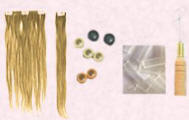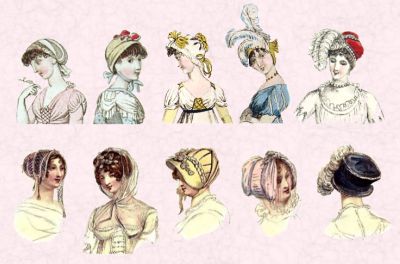By Pauline Weston Thomas for Fashion-Era.com
- Back to Hair & Hats
- The Rise of False Hair to Extend Hairstyles
- Human Hair Extensions
- How are Hair Extensions Applied?
- Clip in Hair Extensions
- Fusing Methods Pre Tipped Extensions, Mini Links, Shrinkies
- Cornrows Bonding of Wefts
The Rise of False Hair to Extend Hairstyles
As far back as Egyptian times both women and men have worn wigs or hair pieces according to the diktats of fashion. Wigs, hair switches or hair pieces have come in and out of fashion in just about every century.
In Georgian times high false wigs were a norm and men also wore bag wigs. The picture to the right shows the ultimate in hair extensions!

Fake hair for women became frowned upon after 1800 and women wore hair more naturally. The addition of false hair returned again with the elaborate Apollo knots of the Romantic era. Later human hair additions were used so extensively in the mid Victorian era of elaborate hairstyling that 51,816kgs of (false) human hair were sold in France in 1871 and 102,900kgs in 1873.
In the early C20th Edwardian women wore false hair additions to create the Pompadour hairstyle that looked like a woman was wearing a teapot on her head.
By the 1920s less hair, rather than more was the vogue. In the 1940s long natural hair in the mode of Veronica Lake or Lauren Bacall was one of the few remaining non rationed luxuries a woman could indulge in
By the 1950s women enjoyed short, but then very sharp bubble cut perms or new youthful ponytails. The latter graduated into topknot buns and sleek French pleat twists by the turn of the decade.
As the 1960s wore on, extravagant human hair pieces allowed wearers to have their hair dressed in coils, or as we think of such styles today, dressed as an updo. Wigs both blatantly fake and real were commonly worn in the 60s and early 70s. By the 1980s hairpieces and wigs were more or less abandoned by the majority, but used extensively by famous singers like Tina Turner, Diana Ross and other celebrities.
Human Hair Extensions
Then came a new type of hair addition - Extensions. At first, extensions were worn only by the very wealthy or celebrities who could afford the then exorbitant cost of laborious all day application. Goths wore frankly fake clip in dreads.

Others followed when they saw what was possible when hair extensions were applied in a glamorous way.
In particular black women used hair extensions to improve upon hair texture that some found difficult to tame.
It became common to see pop singers sport a wide range of looks that centred around hair extensions.
One of the most famous wearers of human hair extensions in Great Britain is Victoria Beckham who must have had dozens of hairstyles based around her extensions.
One day her hair is short - the next day it is long, one day black the next day striped, the next blonde. Then a few weeks later it's a different different hair colour and yet another length again.
In the UK it is Mrs.Beckham and her husband (who has also worn hair extensions) more than anyone else, who put hair extensions at the forefront of the public's attention.
Although both are in the press much less now, it was Victoria Beckham's constant presence in female oriented magazines long after her Spice Girls fame as Posh Spice, that enabled onlookers to see the true potential of hair extensions.
People began to realise that if Victoria Beckham could create a chameleon like personality, with the very same treatment they could also change their image. Makeover shows where extensions are applied, cut and shaped often show such transformations. The message began to sink in among ordinary people. Extensions are for everyone not just Goths who wear pink, white, purple or black dreads, but also those who want to appear über glamorous.
Another well known wearer of hair extensions is Jordan who famously wore braided extensions on a reality TV show on an island and managed to maintain a certain appearance and grooming due to the effect plaiting of the hair extensions.
Now ordinary people certainly consider hair extensions for special events such as weddings, Christmas and holidays. Some people may even consider extensions for cosmetic/medical reasons as I did. Or you might simply like to treat yourself to some as a birthday, Valentine's Day or Christmas gift.
Hair extensions can also be ideal as fancy dress addition to create a totally different image. See here how to create your own unique fashion trend and save a bundle of cash by buying loose peacock tails wholesale.
How are Hair Extensions Applied?
Although people refer to hair extensions that are woven in (sewn in), or fused to the hair as permanent, it would really be better to call these methods semi permanent since they are removable and to then call clip in extensions as temporary extensions.
Fusing Methods
Small sections of long hair can be added to your own hair virtually strand by strand. The most popular methods of application are weaving with cornrows and the fusion method.
Basically in the fusion method about 20 to 50 strands of human extension hair have a warm protein glue applied all around it. Using a clear plastic template to isolate the portion of natural hair from the rest of the scalp, the glued extension hair is then attached to a small portion of a client's hair which is pulled through a hole in the template.
The two lots of hair are rolled together in the fingers until a smooth protein bond is made. Then work begins on another strand. This is why it takes so long to do this tedious procedure. However problems can occur with any fusing method if it is not done on super clean hair that is free of conditioner.
Hair must be clean and free of greasiness or conditioners. Extension removal is best done in the salon where fusion remover and tools can be used to first soften then crack the glue bond.
Pre Tipped Hair Extension Strands
Other methods are similar and use pre tipped hair extension strands. The pre tipped strands have a protein glue on the end which melts with heat.
These pre tipped extension strands are bonded in much the same way with a heated hair connector tool that fuses the pre tipped glue onto a selected strand of the client's natural hair. Some people think this method is better as being pre-measured less glue is used, so there is less to crack and chip away leaving hair better bonded.
Mini Links
Mini links or locks are another method and are applied a bit like gimps which are used to hold beads or pearls on wire floater necklaces. The client's own hair is pulled through the mini link with a special needle similar to a knitting machine needle.
Then the extension strand is pulled through the mini link easily. The mini link is then pressed firmly with a pliers type tool and this locks in the hair into the mini links. No glue is used, so glue damage is avoided and the links lie flat to the head. This method is often combined with braided hair extensions.
Shrinkies
Shrinkies are applied in a similar way and are either clear plastic or dark plastic of about 1cm length. Heat is used to tighten up the shrinkie on the hair and the extension to stop the hair escaping. They are removed by cutting up the length of the shrinkie.

Cornrows
Cornrows are flat braids or tracks that lay close against the scalp. They are a form of plaiting, but are best achieved with underhand work to create a braid rather than overhand work of a typical plait that most of us know. The underhand plaited braid is firmer and stronger and can be acquired as a technique with practice.
Cornrows can be used to create styles on their own or can have extension hair worked into the braid as work progresses. Similar styles were depicted in wigs in paintings from ancient Egyptian tombs. Black activists have worn cornrows or braids for many years.
Bo Derek also wore them to great effect in the film 10. Now both black and white women and men all wear braids with or without the help of extensions. They stay in the hair for 4 to 6 weeks, but need checking to see that damage to both the hair and the scalp is kept at a minimum.
Bonding of Wefts
The last method I will mention is the use of the wefts as found in clip in extensions (minus the clips). Either the snap clips can be removed from clip in extensions or instead buy a 4 foot length of human hair weft and either cut it to your head shape or have your hairdresser do this for you.
Such wefts can be glued to the hair just below hair partings using the special glue sold by hair and wig companies. They also sell the glue remover which is essential to have before you insert the extensions.
Obviously there are other methods of extension application and many hairdressers devise their own intricate combination methods with experience.
But these are the main ways people apply hair extensions. Please note there may be many more application methods not mentioned here, but this is simply a summary of methods I discovered in my research on hair extensions.


